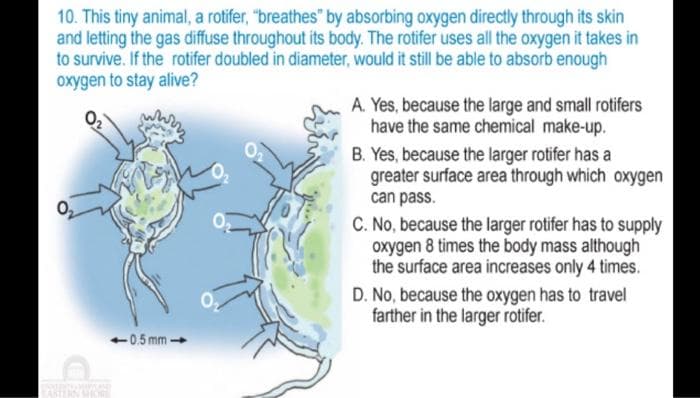10. This tiny animal, a rotifer, "breathes" by absorbing oxygen directly through its skin and letting the gas diffuse throughout its body. The rotifer uses all the oxygen it takes in to survive. If the rotifer doubled in diameter, would it still be able to absorb enough oxygen to stay alive? ENTRE ASTERN -0.5 mm- A. Yes, because the large and small rotifers have the same chemical make-up. B. Yes, because the larger rotifer has a greater surface area through which oxygen can pass. C. No, because the larger rotifer has to supply oxygen 8 times the body mass although the surface area increases only 4 times. D. No, because the oxygen has to travel farther in the larger rotifer.
10. This tiny animal, a rotifer, "breathes" by absorbing oxygen directly through its skin and letting the gas diffuse throughout its body. The rotifer uses all the oxygen it takes in to survive. If the rotifer doubled in diameter, would it still be able to absorb enough oxygen to stay alive? ENTRE ASTERN -0.5 mm- A. Yes, because the large and small rotifers have the same chemical make-up. B. Yes, because the larger rotifer has a greater surface area through which oxygen can pass. C. No, because the larger rotifer has to supply oxygen 8 times the body mass although the surface area increases only 4 times. D. No, because the oxygen has to travel farther in the larger rotifer.
Biology (MindTap Course List)
11th Edition
ISBN:9781337392938
Author:Eldra Solomon, Charles Martin, Diana W. Martin, Linda R. Berg
Publisher:Eldra Solomon, Charles Martin, Diana W. Martin, Linda R. Berg
Chapter46: Gas Exchange
Section: Chapter Questions
Problem 1TYU: Test Your Understanding 1. Which of the following is a benefit of gas exchange in air compared with...
Related questions
Question
Explain.

Transcribed Image Text:10. This tiny animal, a rotifer, "breathes" by absorbing oxygen directly through its skin
and letting the gas diffuse throughout its body. The rotifer uses all the oxygen it takes in
to survive. If the rotifer doubled in diameter, would it still be able to absorb enough
oxygen to stay alive?
ASTERN WOR
-0.5 mm-
A. Yes, because the large and small rotifers
have the same chemical make-up.
B. Yes, because the larger rotifer has a
greater surface area through which oxygen
can pass.
C. No, because the larger rotifer has to supply
oxygen 8 times the body mass although
the surface area increases only 4 times.
D. No, because the oxygen has to travel
farther in the larger rotifer.
Expert Solution
This question has been solved!
Explore an expertly crafted, step-by-step solution for a thorough understanding of key concepts.
Step by step
Solved in 2 steps

Knowledge Booster
Learn more about
Need a deep-dive on the concept behind this application? Look no further. Learn more about this topic, biology and related others by exploring similar questions and additional content below.Recommended textbooks for you

Biology (MindTap Course List)
Biology
ISBN:
9781337392938
Author:
Eldra Solomon, Charles Martin, Diana W. Martin, Linda R. Berg
Publisher:
Cengage Learning

Biology: The Unity and Diversity of Life (MindTap…
Biology
ISBN:
9781337408332
Author:
Cecie Starr, Ralph Taggart, Christine Evers, Lisa Starr
Publisher:
Cengage Learning

Biology: The Unity and Diversity of Life (MindTap…
Biology
ISBN:
9781305073951
Author:
Cecie Starr, Ralph Taggart, Christine Evers, Lisa Starr
Publisher:
Cengage Learning

Biology (MindTap Course List)
Biology
ISBN:
9781337392938
Author:
Eldra Solomon, Charles Martin, Diana W. Martin, Linda R. Berg
Publisher:
Cengage Learning

Biology: The Unity and Diversity of Life (MindTap…
Biology
ISBN:
9781337408332
Author:
Cecie Starr, Ralph Taggart, Christine Evers, Lisa Starr
Publisher:
Cengage Learning

Biology: The Unity and Diversity of Life (MindTap…
Biology
ISBN:
9781305073951
Author:
Cecie Starr, Ralph Taggart, Christine Evers, Lisa Starr
Publisher:
Cengage Learning

Biology: The Dynamic Science (MindTap Course List)
Biology
ISBN:
9781305389892
Author:
Peter J. Russell, Paul E. Hertz, Beverly McMillan
Publisher:
Cengage Learning

Biology 2e
Biology
ISBN:
9781947172517
Author:
Matthew Douglas, Jung Choi, Mary Ann Clark
Publisher:
OpenStax

Anatomy & Physiology
Biology
ISBN:
9781938168130
Author:
Kelly A. Young, James A. Wise, Peter DeSaix, Dean H. Kruse, Brandon Poe, Eddie Johnson, Jody E. Johnson, Oksana Korol, J. Gordon Betts, Mark Womble
Publisher:
OpenStax College